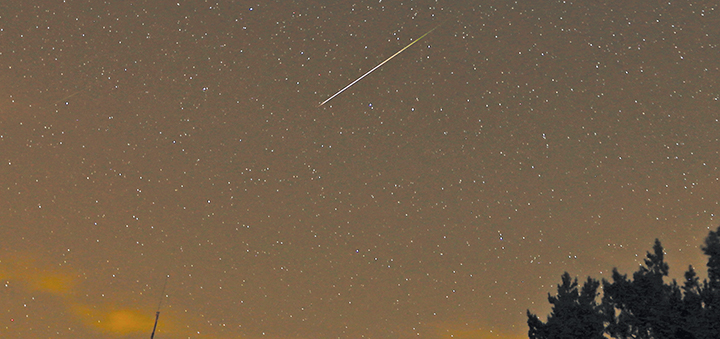August Night Skies Bring Colorful Perseid Meteor Shower This Weekend
Published:
August 11th, 2023
By:
Kelli Miller
 August night skies bring the Perseid Meteor show and dazzling planet displays. According to the online Earth Sky site Perseid meteors have streaked the Earth's sky since mid summer but now with the waning moon, the showers will peak and be easily visible in the mornings of August 11 through 13. (AP Photo/ Francisco Seco, File)
August night skies bring the Perseid Meteor show and dazzling planet displays. According to the online Earth Sky site Perseid meteors have streaked the Earth's sky since mid summer but now with the waning moon, the showers will peak and be easily visible in the mornings of August 11 through 13. (AP Photo/ Francisco Seco, File)
CHENANGO COUNTY – According to the Earthsky.org, the Perseid meteors have streaked the Earth's sky since mid summer but now with the waning moon, the showers will peak and be easily visible in the mornings of August 11 through 13.
The meteor shower is called Perseid because they appear to shoot away from the constellation, known as Perseus.
According to the site, the waning crescent moon will be at about 10 percent illumination during the peak of the shower with the best observation time between 1 and 3 a.m. Daily, the moon is growing fainter before the peak and shouldn’t interfere with viewing. A single observer may see up to 90 bright streaming stars per hour.
The duration of the shower will continue through early September and is one of the most popular in the Northern Hemisphere. It’s known to be one of the most colorful of showers that often leave glowing lengthy trails.
Sidney Central School District operates an observatory that reopened last year after being shut down due to COVID. The school tried to hold at least two public views a year, for more information for sky viewing at the observatory can be found at the Sidney Central School District Facebook page.
Previously, Sidney Central School District Earth Science Teacher Bryan Neubert said, the observatory opened in October for a community observer session.
“We had about 50 people show up to view Jupiter and Saturn,” he said.
“At that time we could see Saturns’ rings perfectly. It’s always a thrill to see kids faces light up when they view the planets,” he said.
Venus
According to the Old Farmers Almanac, Venus travels one step inward from Earth in orbit around the sun. Its orbit is smaller than Earth’s and has less distance to cover. Venus moves between the earth and sun every so often and at these times, astronomers say it’s in “inferior conjunction” with the sun. The conjunction will take place at 6 a.m Central Time August 13 and may be difficult to sight as it will be during daylight hours.
Venus is our closest planetary neighbor and the brightest planet in our sky. It passes between the Earth and the sun about every 19 months (1.6 years).
After blazing as our dazzling evening star for all of 2023, Venus is now so close to sunset it may be impossible to view without special equipment. After the conjunction, it’ll return to the morning sky and will most certainly arouse admiration.
Saturn
The Almanac explained Saturn takes the prize for brightly shining and reaches opposition between August 26 through 27. As the earth passes between the sun and Saturn, the ringed planet will be opposite the sun with its face fully illuminated. Most important to note: The rings will be edgewise and are still open enough to reveal amazing detail. At around midnight Saturn shines at its peak.
Jupiter
In August, our largest planet, Jupiter, will be the brightest natural object in the morning sky except for the moon. At the beginning of August, Jupiter will rise in the east around midnight and by the end of August, it’ll rise around 10 p.m.
The Moon
The new moon occurs on August 16. On the evenings of August 29 and 30, the moon will pass Saturn and will be full on August 30 to 31; making it the 2nd full moon of August. It's called a Blue Moon, also known as a supermoon and will be the closest and biggest full supermoon of 2023.
Author: Kelli Miller - More From This Author
Comments











